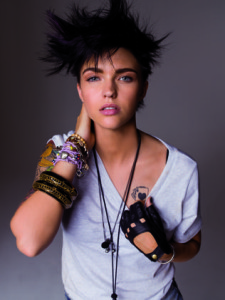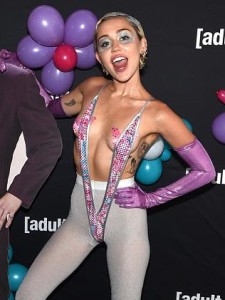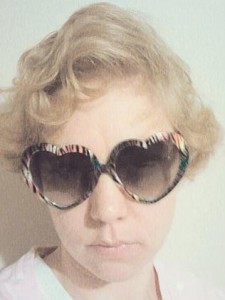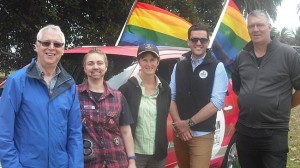Miley Cyrus and Ruby Rose both identify as gender fluid, but what’s it really like?
CELEBRITY hounds will no doubt have watched with interest as Miley Cyrus and Ruby Rose spoke publicly about identifying as gender fluid. But what exactly is it and is it on the rise?
If you’re not familiar with the term, gender fluidity refers to somebody viewing themselves as both male and female. Some gender fluid people will alter their clothing depending on whether they feel more masculine or feminine while for others it’s a state of mind that they don’t outwardly express.
Exact statistics about gender fluidity don’t exist but experts estimate that somewhere between one per cent and eight per cent of the population are “gender diverse”, which ranges from being gender fluid to transsexual (person who identifies as the opposite sex) or genderqueer (person who identifies as neither sex).
While you might have put Miley’s transition from girlie Hannah Montana to her current androgynous style down to fashion preference, but the child star has announced she doesn’t want to be boxed into one gender identity.
“I didn’t want to be a boy … I kind of wanted to be nothing,” she told Out.
“I don’t relate to what people would say defines a girl or a boy, and I think that’s what I had to understand: Being a girl isn’t what I hate, it’s the box that I get put into.”


Meanwhile, Ruby Rose, former MTV VJ and now star of Orange Is The New Black, shared a rare insight into being gender fluid in her short film Break Free, where she transitioned from an ultra feminine version of herself with long blonde hair to a masculine version in a suit.
“The only reason it was a surprise was because gender fluidity doesn’t get talked about enough,” she told Sunday Style this week. “Once the film went viral, the floodgate opened; to me, that said that this was something much bigger than I thought it was.”
For Roxanne Thomson, 29, from Warrnambool Victoria, “coming out” as gender fluid has been a gradual process.
“Ever since I was about 18, I always took the opportunity to dress as a man at fancy dress parties — it was a nice way of exploring what I was,” Thomson says.
Increasingly realising how much this masculine identity was part of her, she started coming to work at Deakin University as her alter ego Bobby J, who wears male clothes and a hand drawn beard, last year.


“It’s something deep within you and I can’t fully explain it,” she says.
“It’s only because I have a supportive partner, family, workplace and community that I have thought, ‘This is who I am and I’m going to fully embrace it’. People bought me ‘It’s a boy!’ and ‘Welcome to the world’ cards, which is a huge thing.”
Thomson describes Roxanne and Bobby J as a “dual identity”.
“I can’t be one without the other,” Thomson says.
“When I’m Roxanne, I’m a highly anxious person and a go-getter. But when I’m Bobby I’m a little more relaxed and more comfortable in myself, which tells me that I’m comfortable accepting Bobby J and that it’s an important part of who I am.”
Now Bobby J makes an appearance about once a month and while Thomson says he might come out more often as time goes on, she does not anticipate transitioning to Bobby J full time.
“I met my partner six years ago as Roxanne and I will honour that commitment because she fell in love with Roxanne,” she says.
“She loves Bobby J but also identifies as a lesbian and I would like to be in a relationship sexually with my partner as Roxanne.”
While celebrities might be bringing gender diversity to the fore, Dr Tracie O’Keefe, a sexologist and psychotherapist, says it’s always existed.
“Gender fluidity is not a new concept — gender diverse people were recognised in societies such as India, Pakistan and Native American cultures,” she toldnews.com.au. “But Anglo Saxon Christian influences tried to wipe out as much trace of it as they could during colonisation.”
Associate Professor Damien Riggs, a Flinders University researcher, says people are talking about gender fluidity more now there is a word to describe it.
“I don’t think that the prevalence rates have changed,” he says.
“The language is getting more traction now with celebrities saying it. More people are saying, ‘I’m gender fluid or gender diverse’ — people are being more assertive about the fact these boxes don’t fit them’.”
Gem DeMarco, 34, identifies as gender queer, not viewing themself as male or female, and asking to be referred to using the pronoun “they” not “he” or “she”.
“I was born female but in my late 20s I grabbed hold of the term genderqueer and felt it encompassed everything,” they told news.com.au. “I identify as neither of the genders and something in between. It is liberating to have a word to describe myself.”
DeMarco says it can be difficult for transgender, genderqueer and gender fluid individuals to navigate a world that is so heavily skewed towards being either male or female — and even transsexuals have been known to discriminate against people who don’t identify as either male or female.
“Everything from work to clothing seems to be in two categories,” they says.
Last year, Sydneysider Norrie, who does not identify as a specific gender and only goes by their first name, made history after winning a High Court battle to be legally recognised as neither male or female.
Norrie started identifying as gender neutral in the 1990s when they began questioning where the ideas of “male” and “female” come from.
“I’ve become the poster child for sex non-specificness,” they told news.com.au.
“It’s okay to be male, to be female, to be in-between, change from one to the other or change from one to both. Whatever you are doing is fine.”
Sally Goldner, from Transgender Victoria, says the number of people identifying as gender fluid or gender neutral will increase as awareness spreads, and with that she hopes will come more acceptance.
“I think we’re going to see more of it as people realise that you just cannot push people into one of two squares that don’t fit,” she told news.com.au.
“Quite frankly, there are seven billion gender identities.









